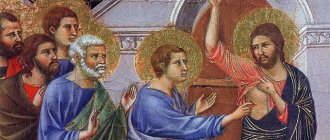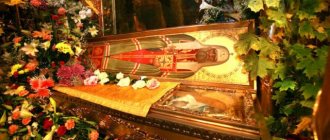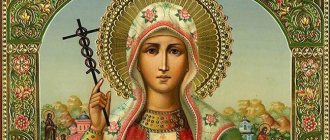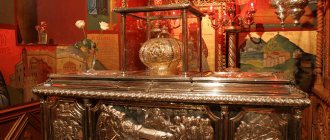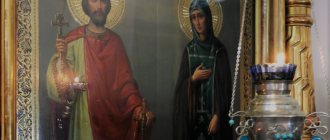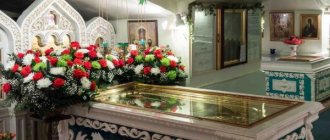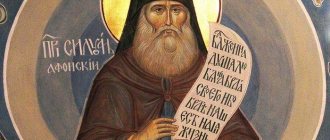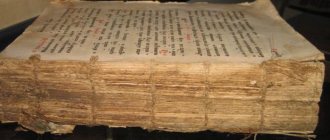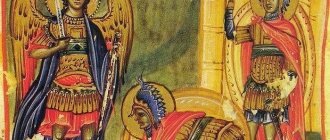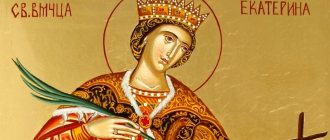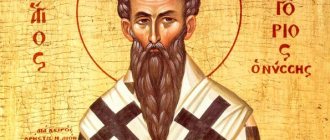Dmitry Solunsky received a Christian education in childhood from his parents. They were not just secret Christians. Dmitry's father held a high position in the administration of the Greek city of Thessaloniki (now Thessaloniki) and was a proconsul. The Christian faith in those days was a death sentence for the whole family. But this danger did not stop the father of the family. There was a secret temple in the house, where Demetrius was baptized according to the faith of his parents. When Demetrius's father died, the right to inherit the position passed to the future Great Martyr Demetrius. Demetrius did not hide the fact that he was a Christian, and was soon arrested by order of the Roman Emperor Maximian, whose main entertainment was the persecution and torment of Christians. The emperor asked Saint Demetrius to renounce Christ, but received a decisive refusal. The Great Martyr Demetrius was stabbed to death with spears in prison. The life of Saint Demetrius is the story of a true Christian warrior. The icon of St. Demetrius with marks depicts his entire martyrdom.
Life of the Great Martyr Demetrius of Thessalonica
Demetrius was born in Thessaloniki (Thessaloniki) in the 3rd century in a family that professed Christianity, was baptized by the will of his parents, and was raised according to the canons of the faith. His father was an aristocrat, Roman proconsul, respected and rich. He hid his Christian faith. He died when the young man had barely reached adulthood.
Emperor Maximian appointed Demetrius to his father's position. The duties of the proconsul included protecting the territory from external enemies and defending the borders. The pagan faith in Rome was weakening at that time, but the authorities supported it with the sword, identifying and exterminating Christians who were forced to hide their beliefs.
Demetrius was obliged to fight the new faith, which was shaking the foundations of the empire. Instead, he preached God's word and supported his fellow believers. For this they imprisoned him and convinced him to renounce. Maximian, who arrived in Thessalonica, decided to organize demonstration executions of Christians to intimidate the population.
Christians were driven out to gladiatorial fights, forced to fight with strong warriors. The defeated were thrown from the arena onto spears. The emperor's favorite, Liy, was distinguished by his special skill. Nestor was a Christian and ally of Demetrius. He came to the prison to the saint and asked him to bless him for the duel.
Nestor challenged Leah to a fight and, with God’s help, managed to win. But instead of the traditional honoring, he was killed by order of the emperor. Having learned about Dimitri's support for the fighter, Maximian ordered his execution too. The saint was killed in prison, pierced with spears. The body was thrown to the animals. Dimitri's servant took the ring off the master and collected his blood for an orarion. Healings later occurred from these objects. Christians managed to bury the saint.
In imperial service
Demetrius's parents, having passed on all their knowledge to him and shown him an example of pious life, ended their earthly journey. Being an adult, he inherited not only the estate, but also his father’s considerable position. It happened like this - Emperor Maximian summoned the young man, remembering the merits of his father. Convinced that the young man was well educated, smart and had administrative abilities, the ruler appointed him to the post of proconsul of the Thessalonian region , that is, in the place of a parent.
The new proconsul received simple and unambiguous tasks - to protect the city from barbarian raids and destroy anyone who invoked the name of the Crucified One. The emperor expected from Demetrius the complete extermination of Christians in the city, but then the opposite happened.
Miracles
Objects soaked in the blood of the great martyr helped people heal. The same miracles were shown at the saint’s burial place. Eparch Leonty received healing after lying on the grave of Demetrius. He ordered a temple to be built over the burial site.
The miracles revealed at the grave, as well as from Demetrius’s belongings, were first described in the 7th century by Archbishop John. Many of them are associated with healing, others with help in military affairs:
- It is known that one eparch could not be cured by healers; he refused to use amulets. Demetrius, who appeared in a dream, ordered him to go to the temple, after which the sufferer recovered.
- In the temple above the grave of the saint, a warrior was freed from demons, whom they could not otherwise bring to his senses.
- By order of someone who wanted to receive part of the emperor’s relics, they tried to open the saint’s tomb. But Dimitri’s voice forbade this, and the workers were thrown away from the grave.
- During the siege of Thessalonica, the city was threatened by the Bulgarian Tsar Kaloyan. It is believed that Demetrius appeared to him at night and stabbed him with a spear. The army left without a leader.
- During the siege by the Avars, the saint in shining armor appeared on the walls of his native city and himself repelled the attack. The warrior who went to the temple witnessed such a miracle - Demetrius stood in the church in a bright glow, the angels persuaded him to leave the besieged city. But the saint refused. He helped his fellow countrymen defeat the formidable army, and sent ships to the harbor to save the townspeople from hunger. Since then, he has been considered the heavenly patron of the city of Thessaloniki.
- The deliverance of the city of Thessalonica from the plague through the prayers of Saint Demetrius dates back to July 586.
Many miracles are associated with the name of the saint in our country. The chronicler Nestor wrote that Prince Oleg’s campaign against Constantinople was successful due to the patronage of Saint Demetrius, who helped the Russian soldiers.
Information: the veneration of the Great Martyr by the Orthodox began immediately after the baptism of Rus'. Serbs and Bulgarians, Russians consider Demetrius of Thessaloniki the patron saint of the Slavic peoples.
Serving God
greeted the proconsul with honors when he returned to his native place . He knew well how many people subordinate to him worshiped pagan idols, and his heart grieved over this. Demetrius began to openly profess faith in Christ and taught the townspeople His commandments. Being not an ordinary resident of the city, he showed an example of true faith; many pagans, thanks to the brave young man, became Christians.
The Word of God, supported by fiery faith, rallied many people around the martyr. The underground galleries of the city became a refuge for them for prayer. The fame of the preacher spread throughout the entire land of Thessalonica.
This could not continue for long; the proconsul knew about the inevitability of imperial punishment . Maximian heard a rumor that the ruler of Thessalonica was openly preaching the teachings of Christ. He, returning from the war, decided to lead troops through this area to check how things really were.
Demetrius did not expect mercy from the emperor, so he instructed his servant to distribute all his property to the poor, and he himself began to fervently pray and fast. He made no attempt to escape, although he had the opportunity.
Demetrius of Thessalonica (12th century icon)
Description of the icon
On the icons, Russian masters paint Demetrius in the garb of a warrior, as a young man. The sword often lies on the lap or hidden in the folds of clothing, more like a cross. This symbolizes that the saint did not die in a fair battle, but was villainously killed. His main feat was death for Christ, martyrdom. Red clothes give the saint’s appearance strength and energy, signifying shed blood and loyalty to the Lord.
Many ancient icons have been preserved, brought from campaigns and painted in Rus'. In the 12th century, the icon of Demetrius, painted on the coffin board, was brought with honor by order of Prince Vsevolod to Vladimir. Before the Battle of Kulikovo she was taken to Moscow. An ancient and revered image of the saint is considered to be the icon painted by Andrei Rublev on the wall of the temple in Vladimir.
Iconography
At the end of the twelfth century, the “tomb board” of St. was brought to Vladimir from Thessalonica. Demetrius of Thessalonica, “myrrh-streaming and miraculous.” In 1380, it was moved to Moscow, has survived to this day and is kept in the local row of the iconostasis of the Assumption Cathedral of the Kremlin. Unfortunately, the original icon has not survived, and the painting on it dates back to the eighteenth century and belongs to the brush of Kirill Ulanov, master of the Armory Chamber.
Demetrius of Thessalonica Ulanov Kirill Ivanov (in monasticism - Cornelius) 1701 [board - XII century.
(?)] 169 × 86 cm Assumption Cathedral of the Moscow Kremlin, Moscow, Russia Inv. Ж-129 See in the “Gallery”: Demetrius of Thessaloniki It is known that he painted the icon in 1701, possibly over the previous image of the saint.
The renewed life-size icon represents the Great Martyr Demetrius of Thessalonica in rich military armor, with a spear and sword. Painted in the exquisite semi-Baroque style characteristic of the Armory, the painting is richly decorated with gold floats. Traditional Russian icon painting adopted St. Demetrius of Thessaloniki not only in the image of a warrior, but also as a meek martyr; if for a Byzantine icon the image of a saint with a weapon, a sword and a spear is traditional, then Russian icon painters partly rethought the image.
The famous Pskov icon of Dmitry of Thessaloniki of the fifteenth century represents the saint in red robes, symbolizing the repetition of the feat of the cross and the obligatory cross in his hand - the foreground of the icon. It is interesting that the sword seems to be hidden behind a shield, and is depicted in a very primitive way.
Dmitry Solunsky School or art. center: Pskov XIV–XVI centuries. (?) 105 × 59 cm State Russian Museum, St. Petersburg, Russia Inv. DRZh-2096 The origin of the icon has not been established. Employees of the State Russian Museum suggest that it was originally performed at the turn of the 14th and 15th centuries, and perhaps not in Rus', but subsequently, in the 16th century, it was almost written anew by the Pskov master.
The face of the Pskov icon also bears archaic features, a perspective distortion of the saint’s face, showing it as if in a dynamic turn towards the beholder and imparting some “menacingness” to the saint’s gaze. Dimitri. The color harmony of the icon, traditional for Novgorod, is composed with a predominance of red cinnabar color, this is a very energetic image.
The oldest known icon of St. Demetrius of Thessaloniki is kept in the State Tretyakov Museum, previously located in the city of Dimitrov. The customer of the icon was supposedly Prince Vsevolod the Big Nest, that is, the icon was painted before 1212.
Dmitry Solunsky on the throne School or art. center: Vladimir-Suzdal school End of the 12th century. Onasch 1961: XII century. Antonova, Mneva 1963: Second half of the 12th century. Rostov-Suzdal painting 1970: End of the 12th century. Tretyakov Gallery 1995: The end of the XII - the beginning of the XIII centuries. Lazarev 2000/1: The end of the 12th century. 156 × 108 cm State Tretyakov Gallery, Moscow, Russia Inv. 28600
The rarity of this iconography lies not only in its antiquity, it depicts St. Demetrius as a mature husband, partially in princely attire. It is believed that the icon painter endowed the great martyr with the features of a prince, emphasizing their heavenly connection (Vsevolod in baptism - Dmitry). On the princely throne there is a “tamga” depicted - the family sign of the prince, who added the words of All Rus' to his title and united the largest Russian principalities.
Relics
The saint's grave has been revered since the time of his burial. Many legends testify that those who came to pray heard a voice sounding from the ciborium and turned to it with requests. Sources from the 7th century report that when the relics were removed from the burial place of the saint, everything around was fragrant with a wonderful aroma, and myrrh was released abundantly. Deep veneration of the relics and blood of Demetrius of Thessalonica developed by the 10th century. The myrrh flow was so abundant that everyone took the precious liquid, used it to treat wounds, and added it to food.
Pilgrims collected myrrh and took it to their lands in vessels. Over time, the silver ciborium was replaced with a marble one, and a double sarcophagus was built for the relics. Before dangerous battles, warriors covered their bodies with myrrh. Icons of Demetrius were made with a small vessel for the precious liquid. With the arrival of Muslims in Thessaloniki and the transformation of the basilica into a mosque, the flow of myrrh stopped.
The burial site was plundered during the Crusades. The relics were taken to Italy. For a long time they were kept in the Abbey of San Lorenzo in Campo. At the end of the 20th century, the relics returned to Thessaloniki. The relics of the saint left Greece more than once; they could be venerated in different countries of the Christian world. Raku was brought to Moscow and Yekaterinburg.
What does a saint help with?
The veneration of the saint in Rus' is traditionally associated with military exploits and the defense of the fatherland. Many princes, famous for their military exploits, called their first sons Demetrius. His namesake, Dmitry Donskoy, deeply revered the saint.
In addition to helping in military affairs, the saint helps:
- to save lives in battle and in dangerous conflicts;
- makes it easier to serve the Motherland, helps military personnel in everyday life in the army;
- protects peace and tranquility, prevents war from breaking out;
- gain firmness in faith;
- imparts courage and resilience;
- keep healthy, heal.
You can ask Demetrius to give you peace in your soul, to ward off despair and bitter thoughts.
Troparion, kontakion, magnification
Troparion, tone 3
Great will you find in troubles/ the champion of the universe, O passion-bearer,/ the conquering tongues./ Just as you brought down Lieva’s pride,/ and you boldly created Nestor for the feat,/ so , Saint Demetrius, / pray to Christ God // to grant us great mercy.
Kontakion, tone 2
With your streams of blood, Demetrius, / God stained the Church, / giving you an invincible fortress, / and keeping your city unharmed // for this is your affirmation.
Greatness
We magnify you, passion-bearing Saint Demetrius, and honor your honest suffering, which you endured for Christ.
Canon
Canon to the Great Martyr Demetrius of Thessaloniki Voice 4
Song 1
Irmos: Ancient Israel walked across the dark abyss with damp feet and defeated the power of Amalek in the desert with the cross-shaped hand of Moses.
We are crowned with divine torment, we rejoice with God, we shine with brilliance from the tedious and we fulfill enlightenment, most wonderful martyr.
As a being of the Truth, a witness, and even having labored to the point of blood, blessedly, patiently; Having shown firm resistance to the tormentor, the Lord accepts you.
You have brought down the recipient of malice to the earth, Demetrius, having killed him with your martyr's copy, with Divine goodness, more than the power of the mind, we strengthen for this, blessed one.
Theotokos: Motherless, as God is above all, who is for us the Fatherless One from You, the All-Singing Mother of God, the flesh is received by unity, more than words and reason.
Song 3
Irmos: Your Church rejoices in You, Christ, calling: You are my strength, Lord, and refuge, and confirmation.
Reckon the commandment from you to the tormentors; You have preceded the Word of God more than all others, most passion-bearing.
You were a priest of the light of torment in the tabernacle, shining with the Divine Light, the passion-bearing martyr Demetrius.
You are a holy and wondrous source of healing, having acquired your city and treasure without stealing, you have been enriched with all joy.
Theotokos: Healing the image of the decayed earthly One, the Most Pure One will clothe You with this, remaining as a Lover of Mankind.
Sedalen, voice 4
As to the valor of the sufferer and the strong warrior of the All-Reigning Christ, we cry out in psalm: Rejoice, adornment and beauty of martyrs; Rejoice, bright star of the Church and wall and refuge of those who come running to you, glorious great martyr Demetrius, save you who sing from all foreign harm and all bitterness.
Song 4
Irmos: You are exalted, having seen the Church on the Cross, the Righteous Sun, standing in your rank, worthy of crying: glory to your power, Lord.
Having conquered the lie of wickedness, having seen the Most High God's Word, crowning you with glory, Demetrius, singing: glory to your power, Lord.
Having established victory over flattery, you accepted the victorious crown of righteousness, Demetrius, calling to your Creator: glory to your power, O Lord.
We direct our life-giving hand, to the quietest refuge you have reached, where, now rejoicing, you call to Demetrius: glory to your power, Lord.
Theotokos: As the Most Sacred of all creatures, You have been vouchsafed to be the One Mother of God; having given birth to Him, You have enlightened the world with the grace of the Knowledge of God.
Song 5
Irmos: You, Lord, my light has come into the world, Holy Light, convert those who sing of You from the darkness of ignorance to faith.
Welcome the fire of Divine love into the hearts, you extinguished the fire of godless idolatry, glorious Demetrius.
Delivering us from troubles, appearing, Demetrius, covering those who praise you with faith and love with your prayers.
Those who diligently flock to your temple with faith, Demetrius, will soon be delivered from ailments and strangled passions.
Theotokos: The Word of God, Consubstantial with the Father, is Yours, O Mother of God, more than mind and words, the Son, Consubstantial with You.
Song 6
Irmos: I will devour Thee with a voice of praise, O Lord, the Church cries out to Thee, having been cleansed of demonic blood, for the sake of mercy the Blood flowed from Thy side.
According to what has come together, we sing of your glorious and luminous memory, and full of miracles, and the gifts of the Holy and Honest, Most Blessed, Spirit.
Resolve my captive sins with your prayers, for the martyr’s boldness to the Lady is invincible, and be my refuge and protection, Demetrius.
Theotokos: You found Your purity in the midst of thorns, like the purest color and full color, O Bogomati! Bridegroom, the Word dwells in Your womb.
Kontakion, tone 2
With streams of your blood, Demetrius, God stained the Church, giving you an invincible fortress and keeping your city unharmed; That is why you are a statement.
Ikos
Let us all sing of this great one, having come together in faith, as the armorer of Christ and the martyr, Demetrius, in songs and singing we call upon the Lady and Creator of the universe: deliver us from cowardice and need, Lover of mankind, through the prayers of the Mother of God and all your holy martyrs. We all hope in You to get rid of troubles and sorrows, for You are our affirmation.
Song 7
Irmos: In the cave of Abraham, the Persian youths, with the love of piety more than being scorched by flame, cried out: Blessed are you in the temple of Your glory, O Lord.
Adorned with Divine glory and grace, O passion-bearing martyr, you shine radiantly and enlighten those who call: blessed art thou in the temple of Thy glory, O Lord.
Like scarlet, adorned with your blood, having instead of a scepter, gloriously, a cross; Thou art now reigning with Christ, martyr Demetrius, blessed art thou, the caller, in the temple of Thy glory, O Lord.
Theotokos: Most Glorified, Enlightened, Mother of the Virgin, protect all who honor Thee, the All-True Mother of God; Blessed are You among women, O All-Immaculate Lady.
Song 8
Irmos: Daniel stretched out his hand, the gaping lions in the ditch were imprisoned: having quenched the fiery power, girded with virtue, the zealous youths of piety, crying out: bless all the works of the Lord the Lord.
Thou hast darkened all the enemy's wrath, gloriously, and, having been clothed with the inalienable power of Christ in the struggle, and having become a victor, the martyr Demetrius, thou cried out: bless all the works of the Lord the Lord.
Having shown the prosperity of the martyrs, the blessing of the martyrs, martyr, you have inherited; Having washed ourselves in the holy bath, even the second is not defiled by sinful pretexts, we pierce it with a spear, and call: bless all the works of the Lord the Lord.
Your miracles are many, more than the talents of the mind, which Christ gave you, he shows everyone, gloriously, and the grace of healing, even more than words, your grace preaches to us, crying out: bless all the works of the Lord the Lord.
Theotokos: One in all generations, the Virgin Mother and the Pure Mother of God, let us hymn: She who is the Intercessor of our salvation, as the Deliverer of the world, gave birth to the Word, to whom we cry: bless all the works of the Lord the Lord.
Song 9
Irmos: The uncut stone from the uncut mountain, to You, Virgin, the cornerstone was cut off, Christ, who united the dispersed nature; Thus, having fun, we magnify You, Mother of God.
Break the bonds of the sins of those who sing, more passion-bearing, set aside the excuses of passions, destroy the rumors of heresies and misfortunes, calm the storm with your prayers.
Direct your most sacred flock to the right paths of the Heavenly Kingdom, crowned martyr Demetrius, to saving pasture, to an eternal place.
May the crowns of glory and the Heavenly Kingdom be received by those who sing this, pray to thee, Martyr Demetrius, Life-Giver of the Lord and King of Powers.
Theotokos: As the root, the source and the guilt of incorruption, You, the Virgin, are all faithful, hoping, we honor with praises; You have exuded the Hypostasis of Immortality for us.
Svetilen
You armed Nestor with the cross, through it you destroyed Leah’s pride, Demetrius, at the tributary, like Christ, you opened your side with a spear, in the image of your flock you guard.
Great Martyr Demetrius was born in the city of Thessaloniki in Greece. His parents, secret Christians, baptized him and instructed him in the faith. His father, the Roman proconsul, died when Demetrius reached adulthood. Emperor Maximian Galerius, who ascended the throne in 305, appointed Demetrius in his father’s place as ruler and governor of the Thessalonian region. Demetrius's main duty was to defend his region from external enemies, but the emperor also demanded that he exterminate Christians. Demetrius instead began to eradicate pagan customs and convert pagans to the faith of Christ. Of course, the emperor was soon informed that Proconsul Demetrius was a Christian. Returning from a campaign against the Sarmatians (tribes inhabiting the Black Sea steppes), Maximian stopped in Thessaloniki. Preparing for death, Demetrius distributed his property to the poor, and he devoted himself to prayer and fasting. The emperor imprisoned the proconsul and began to entertain himself and the inhabitants of Thessaloniki with gladiatorial battles in the circus. Christians were searched for and dragged into the arena. The perky Leah, famous among gladiators, easily defeated meek Christians in battle and, with the rejoicing of the brutal crowd, threw them onto the spears of the soldiers. The young Christian Nestor visited Demetrius in prison, and Demetrius blessed him to fight Leah. Strengthened by God, Nestor defeated the proud gladiator and threw him onto the spears of the soldiers. Nestor should have been awarded as a winner, but instead he was executed as a Christian. By order of the emperor, the prison guards pierced Demetrius with spears in 306.
Murder of the martyr. Dimitri. Icon. 1st quarter XVII century (Benaki Museum, Athens)
The body of the Great Martyr Demetrius was thrown out to be devoured by wild beasts, but the Thessalonians secretly betrayed him to the ground. Dimitri's servant Lupp took the bloody robe and the martyr's ring and began to heal the sick with them. He was also executed. During the reign of Emperor Constantine the Great (324-337), a temple was erected over the grave of the Great Martyr Demetrius, and a hundred years later his incorruptible relics were discovered. At the tomb of the Great Martyr Demetrius, miracles and healings were performed. During the reign of Emperor Mauritius, the Avars living on the Don besieged the city of Thessaloniki. Saint Demetrius appeared on the city wall, and the 100,000-strong army of the besiegers fled. Another time the saint saved the city from famine. The life of Saint Demetrius tells that he freed prisoners from the yoke of infidels and helped them reach Thessaloniki. From the 7th century During the cancer of Saint Demetrius, fragrant and miraculous myrrh began to flow, as contemporaries wrote about. In the XIV century. Demetrius Chrysologist wrote about it: myrrh “in its properties is not water, but it is thicker than it and does not resemble any of the substances known to us... It is more amazing than all the incense, not only artificial, but also naturally created by God.” For this reason, the Great Martyr Demetrius was called Myrrh-Streaming.
Demetrius of Thessalonica, Martyrius of Zelenetsky and John Chrysostom
Apostle Philip, Saints Theodore and Demetrius
St. Martyr. Georgy and Dimitri
Church veneration of the Holy Great Martyr Demetrius in the Russian Church began immediately after the Baptism of Rus'. To the beginning 70s XI century refers to the founding of the Dimitrievsky Monastery in Kyiv, later known as the Mikhailov-Golden-Domed Monastery. The monastery was built by the son of Yaroslav the Wise, Grand Duke Izyaslav, in Baptism by Demetrius († 1078). The mosaic icon of St. Demetrius of Thessalonica from the Cathedral of the Dimitrievsky Monastery has survived to this day and is located in the State Tretyakov Gallery. Since ancient times, the memory of Saint Demetrius of Thessalonica has been associated in Rus' with military feats, patriotism and defense of the Fatherland. The saint is depicted on icons as a warrior in feathered armor, with a spear and sword in his hands. On the scroll (in later images) they wrote a prayer with which Saint Demetrius addressed God for the salvation of his native Thessaloniki: “Lord, do not destroy the city and the people. If you save the city and the people, I will be saved with them; if you destroy them, I will die with them.” In the spiritual experience of the Russian Church, the veneration of the Holy Great Martyr Demetrius of Thessalonica is closely connected with the memory of the defender of the Motherland and the Church, the Grand Duke of Moscow Demetrius of Donskoy († 1389). “The Sermon on the Life and Repose of Grand Duke Dimitri Ivanovich, Tsar of Russia,” written in 1393, like other ancient sources, praises him as a saint. Spiritual son and pupil of Metropolitan Alexy, Saint of Moscow († 1378; commemorated February 12), student and interlocutor of the great prayer books of the Russian land - St. Sergius of Radonezh († 1392; commemorated September 25), Demetrius of Prilutsk († 1392; commemorated February 11), St. Theodore of Rostov († 1394; commemorated November 28), Grand Duke Demetrius “was very sad about the churches of God, and held the country of the Russian land with his courage: he defeated many enemies who came against us and fenced his glorious city Moscow with wonderful walls.” Since the time of the white-stone Kremlin built by Grand Duke Dimitri (1366), Moscow began to be called White-stone. “The Russian land flourished during the years of his reign,” the title “Word” testifies. Through the prayers of his Heavenly patron, the holy warrior Demetrius of Thessaloniki, Grand Duke Demetrius won a series of brilliant military victories that predetermined the further rise of Russia: he repelled the onslaught of the Lithuanian troops of Olgerd on Moscow (1368,1373), defeated the Tatar army of Begich on the Vozha River (1378), crushed military power of the entire Golden Horde in the battle on the Kulikovo field (September 8, 1380 on the day of the celebration of the Nativity of the Blessed Virgin Mary) between the Don and Nepryadva rivers. The Battle of Kulikovo, for which the people named Dimitri Donskoy, became the first all-Russian national feat that rallied the spiritual forces of the Russian people around Moscow. “Zadonshchina,” an inspired heroic poem written by priest Zephaniah Ryazan (1381), is dedicated to this turning point in Russian history. Prince Dimitry Donskoy was a great admirer of the Holy Great Martyr Demetrius. In 1380, on the eve of the Battle of Kulikovo, he solemnly transferred from Vladimir to Moscow the main shrine of the Vladimir Demetrius Cathedral - the icon of the Great Martyr Demetrius of Thessalonica, written on the board of the saint’s tomb. In the Moscow Assumption Cathedral, a chapel was built in the name of the Great Martyr Demetrius. In memory of the soldiers who fell in the Battle of Kulikovo, Dimitrievskaya Parental Saturday was established for church-wide commemoration. For the first time, this requiem service was performed at the Trinity-Sergius Monastery on October 20, 1380 by St. Sergius, Abbot of Radonezh, in the presence of the Grand Duke Demetrius Donskoy himself. Since then, it has been celebrated annually in the monastery with the solemn commemoration of the heroes of the Battle of Kulikovo, including the schema-monks-warriors Alexander (Peresvet) and Andrei (Oslyabi).
The Legend of the Miracles of the Great Martyr Dmitry of Thessalonica
There are several collections of stories about the miracles of Dmitry Thessalonica, 2 of which were created in the 7th century. in Thessalonica, are considered the most ancient, they formed the basis of all subsequent ones. They show the main features of the image of the great martyr and the nature of his exploits. The author of the oldest collection (Collection I - BHG, N 499-516) is Archbishop John of Thessaloniki (late 6th - early 7th century), the creation of his work dates back to the reign of Emperor Heraclius (610-641). John's collection consists of 15 thematically selected miracles.
Miracle 1 “About Eparch Mariana”
Eparch Marian of Illyricum began to indulge in gluttony, carnal passions and other sins, from which he became seriously ill, and no treatment could help him. Marian rejected the magical amulet offered to him, preferring the salvation of his soul to recovery. Then Dmitry of Thessalonica appeared to him in a dream and ordered him to go to his temple. After spending the night in the Church of the Great Martyr, Marian was healed. This event could have taken place no earlier than the middle of the 5th century, when, after the fall of Sirmium, Thessalonica became the residence of the ruler of Illyricum. It is possible that it was borrowed by John from an older collection.
Miracle 2 “About the One Who Bleeded”
A certain military leader who served under the rule of the Eparch of Illyricum suffered from severe stomach bleeding. Since he was known for his faith and gentle disposition, the whole city sympathized with him, but not a single medicine helped him. Nearing death, he asked to be taken to the temple of the city's main defender. When asked who it was, he answered: “Dionysius of Thessalonica.” He received healing in his temple.
Miracle 3 “About the Plague”
John describes in detail an epidemic from which infants, soldiers, and rulers died. Trusting in the help of the patron saint of Thessalonica, Dmitry of Thessalonica, people prayed earnestly all night in his temple, and the next morning many of them began to recover, while those who remained at home died. This event dates back to July 586. The next group of miracles (4-7) in Collection I belongs to the category of “spiritual healing,” or deliverance from delusions.
Miracle 4 "Odemons"
Tells about a warrior who was possessed by demons and could not pray. His comrades took him to the temple of Dmitry Thessalonica and laid him there, and the next morning his sanity returned to him.
Miracle 5 “On the Claim of the Relics of a Martyr”
Emperor Mauritius demanded that Archbishop Eusebius of Thessalonica send him the relics of Dmitry of Thessalonica to help him in the war. Eusebius refused the emperor, recalling that the emperor Justinian had tried in vain to obtain the relics of the saint. Then the church ministers decided to open the relics by excavating at their supposed location, but were stopped by a sudden flame and the voice of Dmitry of Thessaloniki, who forbade them to do this.
Miracle 6 “About the Silver Throne”
During a fire in the Temple of Demetrius of Thessalonica, the silver ciborium over the tomb, the main decoration of the temple, was destroyed. Archbishop Eusebius, in order to compensate for the silver missing to restore the ciborium, decided to melt the throne located in the temple, but Dmitry appeared to one of the priests in a dream and forbade him to do this. However, Eusebius did not believe him, then Dmitry appeared to the priest for the second time, and 18 months later for the third time, this time promising to take care of the ciborium. Soon Eusebius was approached by someone named Mina, and then by other donors of silver for the restoration of the ciborium.
Miracle 7 “About the sexton Onesiphorus”
A certain young man, Onesiphorus, whose duty was to light candles and arrange lamps in the temple of Demetrius of Thessaloniki, began to steal and sell candles, and embezzle money. Dmitry appeared to him in a dream, but Onesiphorus did not heed the saint’s warning. One night he wanted to steal candles from the ciborium, but was stopped by Dmitry's voice from the coffin. Onesiphorus fell as if struck by thunder, and when he woke up, he repented and abandoned his sinful passion. The miracle took place during the time of Eusebius (John's predecessor on the ecclesiastical throne of Thessalonica), but before he became a bishop, that is, before 586. Miracles 8-15 tell about the protection of Thessalonica from various disasters.
Miracle 8 “About the help of the great martyr in famine”
After the siege of the city was lifted, famine set in, as the attacking barbarians destroyed the crops and all supplies in the area. In addition, due to rumors that Thessalonica had been captured, merchant ships stopped coming to the city. Residents were in danger of starvation. Then the great martyr appeared in a dream to Stephen, the captain of ships with grain going to Constantinople, and ordered him to change course and sail to Thessalonica. The saint walked along the sea ahead of the ship and showed the way. When the captain arrived in the city, he spoke about the vision of Dmitry of Thessalonica, who for the first time showed miraculous power outside the walls of Thessalonica. The event dates back to the autumn of 586.
Miracle 9 “About helping a martyr in famine another time”
The Great Martyr sent ships with food to his hometown, which was threatened by famine, but this time he did not appear to the merchants, but inspired them to go to Thessalonica. Dated ca. 610
Miracle 10 “About Lady Eutaxia”
The story dates back to the bloody civil war under the Emperor. Phocas (602-610), which began in the East (Cilicia, M. Asia), and then spread to Illyricum and Thessalonica. One man, who had recently arrived in the city and was still unfamiliar with it, dreamed that he was in the temple of Demetrius of Thessalonica, on the left side of which there was a ciborium of extraordinary beauty. He asked what kind of building this was, and he was told that, according to rumors, a great martyr rested there. Dmitriy. The man wanted to look inside, and the gates of the ciborium were opened for him. There he saw a kind of silver bed, at the head of which there was a golden throne strewn with precious stones, and Dmitry himself was sitting on it. At the bottom of the bed there was another throne, made of silver, on which sat a beautiful noble woman. She got up and took a step towards the door, but the saint stopped her and asked her not to leave the city that needed her. The dreamer asked who she was and received the answer that she was a certain Eutaxia. She was sent by God to be a companion to Dmitry of Thessalonica. The dream was interpreted as a sign that the great martyr was not allowing Eutaxia to leave the city, which was experiencing civil strife. This miracle contains the most detailed description of the ciborium, the supposed tombstone of Demetrius of Thessalonica.
Miracle 11 “On the Blasphemous Eparch”
The central figure here again is a certain eparch of Illyricum, who was very arrogant and treated the citizens with contempt. When he reached the point of blasphemy, he was struck by illness as punishment: his body was covered with terrible ulcers. So he suffered for almost a year and was delivered from the disease only after he confessed with tears in the temple of Dmitry. This miracle dates back to ca. 586 Miracles 12-15 contain a description of the military assistance provided by Demetrius of Solonsky to the city. All of them relate to historical events witnessed by the contemporaries of Archbishop John.
Miracle 12 “On the combustion of ciborium”
On the 2nd day of the holiday in honor of Dmitry (October 26), on the night of October 28, the ciborium caught fire and molten silver flowed like a river across the floor. Awakened townspeople rushed to put out the fire. When the fire was extinguished, and the townspeople had not yet dispersed, the church servants began to fear that the temple would be robbed, and did not know how to get people out of it. Then Dmitry inspired one of them to declare a false alarm about a barbarian attack. Soon the crowd dispersed and the servants began to calmly collect the molten silver. When the townspeople, armed, climbed the walls of the city, it turned out that the Slavic army had actually quietly approached Thessalonica. The battle lasted all day until the attackers retreated. This miracle contains the earliest mention of the saint's feast day - October 26. It is difficult to assign the event to a specific year, and proposed dates range from 584 to 609.
Miracle 13 “About the siege of the city”
Archbishop John calls it “the most important of the martyr’s miracles,” which saved Thessalonica from certain destruction. Having planned to cause as much grief as possible to the Emperor Mauritius, the leader (khagan) of the Avars gathered the Slavs subordinate to him and marched with a huge army against Thessalonica. Sweeping away everything in its path, the army advanced towards the city faster than could have been expected. But Dmitry sent darkness to the enemies, so that they took the MC fortress. The matrons went out of town and stayed there, only discovering the mistake by dawn. When the assault on the city finally began, Dmitry appeared on the wall in the equipment of a heavily armed warrior and threw the first barbarian from those climbing the stairs onto the wall with a spear. As he fell, he carried everyone else with him. Overcome with fear, the barbarians retreated from the walls. After the first failure, the Avars and Slavs surrounded the city with a tight ring. The townspeople were gripped by horror, as they had never seen so many barbarians up close. In addition, the population of the city was greatly reduced after the plague epidemic, and salvation seemed impossible.
Miracle 14 “About the singer”
It is believed that initially Miracles 13-14 were a single story, which, due to its large volume, was divided into 2 parts. The 1st talks about how Dmitry prevented the barbarians from suddenly capturing the city, the 2nd talks about how Thessalonica was delivered from the siege. At the center of each of the stories is a miracle associated with the appearance of the great martyr to provide military assistance, but in addition, there are several other miracles of the saint, which explain the successes of the townspeople and the failures of the barbarians during the siege. A few days before the appearance of the barbarians, Archbishop Eusebius dreamed that he was in the city theater, where a certain singer was going to sing about him and his daughter. Waking up, Eusebius guessed that his daughter was Thessalonica. Knowing that dreams of this kind foreshadow misfortune, he prayed day and night. When the barbarians attacked the city, he immediately understood what the singer had prophesied. The city did not have enough people, money or weapons to repel the attack. But suddenly, to the surprise of the attackers, warriors who had come from nowhere appeared on the walls - it was God who sent his army to help. The author describes in detail the siege, during which the barbarians came close to taking the city several times, but Dmitry helped repel the attacks, and the attackers returned to the camp empty-handed. On the 7th day of the siege, the barbarians decided to undertake a decisive battle. However, on the appointed day, they unexpectedly retreated from the walls of the city, overcome with horror. As they retreated, they robbed and killed each other. Defectors on their side said that the day before they saw an army ride out of the city gates, led by “a fiery and shining man on a white horse and dressed in white clothes.” The townspeople realized that it was an angelic army led by Dmitry of Thessalonica. This event can be attributed to 586 or 597. Most researchers are inclined to date September 22-29, 586.
Miracle 15 “On the Appearance of Angels”
Angels talk with the military commander. Demetrius about the fate of Thessalonica. The mark of the icon “Vmch. Demetrius of Thessalonica with his life" Beginning. XVI century
On the 3rd day of the siege, one illustration was a vision in the temple of the great martyr: 2 angels knocked on the gates of the ciborium.
The gates opened, and the illustrator saw Dmitry of Thessalonica inside, from whom a dazzling light emanated. The angels told him to leave the city, which God was delivering into the hands of the pagans. Dmitry was saddened and asked the angels to convey to God his request not to give up the city or to allow him to lay down his soul for the inhabitants of the city. The angels disappeared, and Dmitry. returned to the tomb. The next morning the barbarians were put to flight. This miracle is of great importance for the formation of the image of the saint as a defender of the fatherland, who refuses to leave the city, punished for its sins, and begs for forgiveness from God. Collection II
(BHG, N 516z - 523) arose as a direct continuation of Collection I. In the introduction, the author gives reasons to attribute its compilation to the 80-90s. VII century Collection II has been preserved in a single manuscript (Paris. gr. 1517), where it follows Collection I. Neither the name of the author nor his social position are known, i.e. The house page with the beginning of the 1st chapter has been lost, but from the work it is clear that the author was a resident of Thessalonica. Collection II consists of 6 Miracles and is more rich in historical information than Collection I. All Miracles (except the 6th) are related to the defense of the city from barbarians.
Miracle 1 “On equipping the ships of the Droguvites, Sagudates, Velegesites and others”
tells about the miracles of Dmitry of Thessalonica, performed during the attack on Thessalonica by the fleet of Slavic tribes. Before starting the siege of the city, the Slavs, attacking from the sea on monoxyl ships (single-shafted ships), devastated other regions of Greece - Thessaly, Epirus, Achaia, captured most of the Greek islands and reached the shores of Asia Minor. They prepared sophisticated siege weapons for the assault on Thessalonica. When, after 3 days of preparations, the Slavs launched an assault, they saw Dmitry in a white robe walking around the wall and walking along the sea as if on land. And then the Slavic ships became uncontrollable, collided with each other and capsized. A headwind blew, and the surviving ships were unable to turn back; they were barely able to move away. The Slavs planned to capture the city from the inside. Their leader, named Hatzon, wanted to secretly enter Thessalonica, but was discovered and handed over to the townspeople. In memory of this, there was an image not far from the unpreserved temple of Dmitry of Thessalonica in the area. Xylon. The Slavic naval attack on the city is dated to ca. 615 About the active actions of the Slavs in the Balkans in the first decades of the 7th century. Other Byzantine authors also report, but Collection II is the only source that allows us to reconstruct the course of events in the southern regions of the peninsula. During the attack, the Slavs brought their families to Thessalonica, intending to capture the city and settle here. Their naval operations covered almost the entire coast of Greece, including the Peloponnese, with adjacent islands, the maritime zone of Macedonia and the shores of Asia Minor. First, the Slavs needed to capture the interior regions of the peninsula. The fact that Thessalonica survived under these circumstances was perceived by contemporaries as a miracle.
Miracle 2 “About the Kagan’s War”
Having failed at Thessalonica, the Slavs sent many gifts to the Avars, promising to give even more if they helped them capture the city. Gathering all the tribes under his control, the kagan marched against Thessalonica. This attack was even more dangerous than the previous one. Archbishop John tried to support the spirit of the besieged; he climbed the walls, calling for hope in the help of God and Dmitry of Thessalonica. One of the townspeople, having written the name of the great martyr on a stone, threw it at the enemies, who collided with another large stone thrown by the Slavs and turned it back. Both stones fell on the barbarians' catapult, causing great casualties. On the same day, a strong earthquake occurred, the barbarians saw that the wall had collapsed and rushed into the city, but as they approached, they were convinced that the wall stood as before. The arrows fired by the barbarians turned against them. Suddenly, the city's harbor was filled with ships carrying various supplies. The sailors said that they were sent by an unknown official, but the townspeople immediately realized that it was Dmitry, since the country did not yet know about the sudden attack of the barbarians on Thessalonica. The Kagan, seeing that he could not take the city, agreed to the ransom and retreated. The siege lasted 33 days. It is dated to 618.
Miracle 3 “On the earthquake and the burning of the temple”
Shortly after the siege discussed in the previous Miracle, Archbishop John had a vision of an earthquake in the city. He asked God to delay the punishment until his death. His prayer was heard. About a month after the death of Archbishop John, an earthquake occurred. The tremors continued for several days, but the first one was especially strong, so that part of the city immediately collapsed, but none of the townspeople died, having managed to leave their houses and the city under the care of Dmitry. Another miracle was that the Slavs who were nearby did not attack Thessalonica. They said that when they saw the city destroyed and the gates open, they took tools to clear the rubble and went for the property of the townspeople, deciding that everyone had died. As they approached, they discovered that the city stood as before, and there were armed guards on the walls. What exactly the miracle was can be interpreted in two ways: either the Slavs became victims of an illusion, or the walls really collapsed, and Dmitry restored them. During the disaster, Dmitry of Thessalonica himself appeared to guard the city, and this time he walked accompanied by other saints. Soon after the earthquake, the temple of Dmitry caught fire. Despite all efforts, they could not put out the fire, and the basilica was completely destroyed. The Thessalonians perceived this as punishment for their sins, and some decided that Dmitry asked God to punish his temple in order to divert even greater punishment from the city. Dmitry of Thessaloniki, appearing in a dream to one righteous man, said that the temple would be restored. The described events date back to the 20s or 30s. VII century Miracle 3 ends the story about the events of the time of Archbishop John. The following Miracles refer to subsequent decades and relate events of which the unknown author of Collection II was a contemporary.
Miracle 4 “About famine and siege due to Perwood”
This text is the largest in the Collection, and it is the most historically valuable. The author divides it into several. parts. The plot is based on the attempt of the Slavs, who had long settled around Thessalonica, to capture the city. The reason for the confrontation was the arrest of the Slavic prince, who was in the city. Perwood. Slavic tribes surrounded the city on all sides, so that the inhabitants were in danger of starvation. To save his compatriots, Dmitry performed several miracles. According to his trade, Perwood was caught, who managed to escape after the first arrest. Then he stopped the flight of residents to the Slavs due to severe famine: Dmitry inspired the latter with the idea of selling the townspeople into slavery to the Slavs of the interior regions of the peninsula. After some time, when only the weakest remained in the city, as all the young and strong sailed on ships for food to Thessaly, the Slavs decided to storm. Then Dmitry, appearing in person with a rod in his hand, drove the enemies away from the gate. Thanks to this miracle and the fact that, despite the siege engines on the one hand and the exhaustion of the defenders on the other, the enemies still could not take Thessalonica, they realized that the city had patron saints. When the imperial army came to the rescue, peace was concluded with the Slavs. The main miracle in this lengthy plot is the conversion of the Slavic master inventor to Christianity. A certain craftsman decided to build an unusual siege machine in the form of a tower, which could accommodate warriors with a variety of weapons. But Dmitry appeared to him, hit him in the face, and the master lost his mind. He fled to the mountains, where he began to live like a wild animal. Having come to his senses, he found out who the saint who had appeared to him was, and soon received baptism. This important episode outlines a new line in the saint’s miracles - the conversion of pagans to Christianity. The blockade of the city by the Slavs took 2 years and most likely dates back to 676-678.
Miracle 5 “About the internecine war planned against the city by the Bulgarians Moor and Coover”
The plot refers to a turning point in the history of the Balkan Peninsula, when the Avars are no longer mentioned in the sources, the Slavs become an important demographic element, and the Bulgarians begin to pose a serious threat. The text shows how quickly the situation in Macedonia and on the peninsula as a whole was changing. Some of the subjects of the Avar Kagan, descendants of the Greeks who had once been captured and mixed with the Slavs and Bulgarians, decided to leave the Kaganate and return to the rule of the empire. Having crossed the Danube, they reached Thessalonica and camped near the city. A Bulgarian named Kuver, who led this exodus from the Kaganate, did not want to let go of the people who were trying to return to the city of their ancestors, for fear of losing power. People began to flee from him to Thessalonica. Then Coover decided to send a man loyal to him named Moor to the city in order to cause a “civil war” there. The implementation of this plan was prevented by Dmitry Solunsky. He appeared in a dream to the commander of the ships, Sisinius, near the island of Skiathos and ordered him to urgently move towards the city, while the great martyr made the wind fair. The arrival of Sisinius' ships saved Thessalonica. These events date back to the 80s. VII century The Moor's seal and other evidence confirming the authenticity of the information have been preserved. This miracle ends the stories about the sieges of the city by barbarians. According to the author, all their attempts to take possession of Thessalonica were doomed to failure, for the city as the home of Demetrius of Thessalonica was supposed to remain untouched.
Miracle 6 “About Bishop Cyprian”
who went from Africa to Constantinople. Off the coast of Hellas, he was captured by the Slavs and fell into slavery. One day a certain young man in military clothing appeared before him and said that his name was Demetrius and his house was in Thessalonica. He ordered Cyprian to follow him, but to remain silent along the way and not address him. After 8 days, Cyprian reached Thessalonica and his guide disappeared. The bishop looked for the house of the warrior Demetrius in the city to thank him; in the temple of Demetrius of Thessaloniki he recognized his companion on the icon and told the Archbishop of Thessalonica about everything. Upon returning to Africa, Cyprian erected a temple in his homeland in the name of Dmitry of Thessalonica, who himself helped him get marble for construction. In this temple, many were healed from scorpion stings by anointing themselves with oil from a lamp in front of the icon of the Great Martyr.
The Miracle of Radomir
The Bulgarian Tsar Radomir was a man of fierce temper. His favorite pastime was hunting, during which he poisoned people with animals. Driven to despair, the subjects begged Dmitry to deliver them from their tormentor. Once, during a hunt, having lured Radomir to a hard-to-reach place, the great martyr appeared before him on horseback, threw Radomir off his horse with one blow and pierced him with a spear, and then became invisible. We are talking about Gabriel Radomir (1014-1015), who was the son of the Bulgarian king Samuil and led the Bulgarians’ struggle against the Byzantine conquest. He was killed by his cousin Ivan Vladislav during a hunt, as evidenced by some historical sources.
Miracle about Kaloyan
Miracle of the Great Martyr. Demetrius about Tsar Kaloyan. Icon. XVIII century
The Bulgarian Tsar Kaloyan (1197-1207), having ravaged many cities in Thrace and Macedonia, was going to capture Thessalonica, where the myrrh-streaming relics of Dmitry of Thessalonica were kept. He approached the city and settled down to rest. At night, Dmitry appeared to him on a white horse and stabbed him in the heart with a spear. Kaloyan woke up with a deep wound and told the military leader Manastyr about the vision. Kaloyan died, and his army, gripped by horror, fled, taking the king’s body. Kaloyan was the younger brother of the founders of the Second Bulgarian Kingdom, Peter (Theodore) and Asen (Belgun). It is known that he died suddenly or was killed at night in his tent on the eve of the assault on Thessalonica. The Bulgarians immediately retreated from the city, and the killers were not found. The mysterious death of Kaloyan gave rise to many rumors, on the basis of which the story of John Stavrakis was written down. The legend of the murder of Kaloyan by Dmitry of Thessalonica is also found among Western writers Alberic and Robert de Clary (XII-XIII centuries).
Prayers to the Holy Great Martyr Demetrius of Thessaloniki, the Myrrh-Streamer
First prayer
Holy and glorious Great Martyr of Christ Demetrius, quick helper and warm intercessor of those who flow to you with faith! Standing boldly before the heavenly King, ask Him for forgiveness of our sins, and that we may be delivered from the all-destroying plague, cowardice, flood, fire, sword and eternal punishment. Pray for His goodness to show mercy to this city, this temple and every Christian country. Seek from the King of those reigning victory and victory over the enemies, but for our entire power, peace, silence, firmness in faith and advancement in piety: for us, who honor your honorable memory, ask for grace-filled strengthening for good deeds, so that what is pleasing to our Master, Christ God, who works here, may be worthy through your prayers to inherit the kingdom of heaven, for His eternal glorification with the Father and the Holy Spirit. Amen.
Second prayer
Holy Great Martyr of Christ Demetrius! Standing boldly before the Heavenly King, ask Him for forgiveness of our sins and for us, the accursed (names), to be delivered from the all-destructive plague, fire and eternal punishment. Pray for His goodness to favor this parish (or house) and our temple. Ask us for grace-filled strengthening for good deeds, so that what is pleasing to our Master, Christ God, who works here, may be worthy through Your prayers to inherit the Kingdom of Heaven and there glorify Him, with the Father and the Holy Spirit, forever and ever. Amen.
HISTORY of the city of Vladimir.
Dmitrievsky Cathedral. Orthodox Saints and Apostles. Which saint should I contact?
Copyright © 2015 Unconditional love
Prayer
First prayer
Holy and glorious Great Martyr of Christ Demetrius, quick helper and warm intercessor of those who flow to you with faith! Standing boldly before the Heavenly King, ask Him for forgiveness of our sins and to save us from the all-destructive plague, cowardice, flood, fire, sword and eternal punishment. Pray for His goodness to protect this city, this monastery and every Christian country. Seek from the Tsar of those reigning for victory and victory over the enemies of the Orthodox Christians, the entire Orthodox state, peace, silence, firmness in faith and advancement in piety; For us, who honor your honorable memory, ask for grace-filled strengthening for good deeds, so that our blessed Lord Christ God, who works here, may be honored through your prayers to inherit the Kingdom of Heaven new for His eternal glorification with the Father and the Holy Spirit. Amen.
Second prayer
Holy Great Martyr of Christ Demetrius! Standing boldly before the Heavenly King, ask Him for forgiveness of our sins and for us, the damned (names), to be delivered from the all-destructive plague, fire and eternal punishment. Pray for His goodness to protect this parish (house) and our temple. Ask us for grace-filled strengthening for good deeds, so that what is pleasing to our Master Christ God, who works here, we may be honored through Your prayers to inherit the Kingdom of Heaven and there glorify Him with the Father. m and the Holy Spirit, forever and ever. Amen.
Temples in the name of the Great Martyr Demetrius in Rus'
Monasteries and churches in honor of St. Demetrius have long been built in Rus'. The Russian princes considered the heavenly warrior their patron, intercessor, and suppliant before the Lord. Some of the most glorious and famous temples now include:
- Dmitrovsky Church on Blagush, Moscow. Built in the early 20th century, restored and rededicated in 2012.
- Demetrius Cathedral, Vladimir. Built by order of Prince Vsevolod at the end of the 12th century. The temple is included in the UNESCO World Heritage List. Famous for its white stone carvings.
- Church of Dmitry of Thessalonica with a bell tower, Veliky Novgorod. The temple was founded in 1381 and is now being restored.
- Church of the Great Martyr Demetrius of Thessalonica of the Russian Ancient Orthodox Church, Lgov, Kursk region. Built at the beginning of the 20th century by Old Believers on the site of an ancient monastery.
- Church of the Old Believers in the Krasnodar region, Novonekrasovsky farm.
Several churches in honor of the Great Martyr Demetrius were built in different years in Ukraine.
Martyrdom
The emperor, deciding that Demetrius was the cause of Luy's death, ordered him to be stabbed to death with spears in the place where he was in custody. This is how a brave young man died as a martyr; this happened in 306 .
The body of the deceased was abandoned to the mercy of fate. Demetrius's disciples, arriving at night, betrayed him to the ground. The martyr remained buried in the same place.
Even during his lifetime, the saint performed healings for people who believed in God. many miracles took place at his resting place . The time has come and the idols were destroyed, Orthodoxy shone. The bishop ruling the Illyrian diocese, named Leontes, was passing through Thessaloniki and fell seriously ill. When they brought him on a stretcher to the grave of St. Demetrius, the sick man was miraculously healed, leaving those around him in amazement. As a token of gratitude, Leontes erected a temple on this site in honor of the martyr of Christ.
Martyrdom of St. Dimitri. 15th century icon
Days of celebration
The Great Martyr Demetrius is glorified in the Orthodox Church on November 8 - the day of his tragic death for his faith. The day before, deceased loved ones are commemorated; the day is called Dmitrievskaya Parental Saturday. The saint is honored as a warrior and martyr for Christ, and services are held in churches. You can pray to the saint at your home icon. Requests and prayers on this day have special power.
Demetrius of Thessalonica protects Russia from enemies, helps soldiers defend their fatherland. The saint is revered for his steadfastness of faith, as a true Christian who did not want to abandon the Lord for the sake of well-being, or to save life at the cost of renunciation. Particular reverence has developed among the military who stand in defense of the Motherland, people who serve the Fatherland and think about its good.
